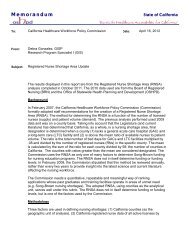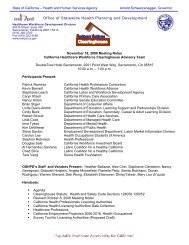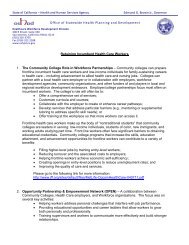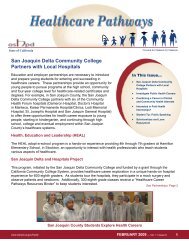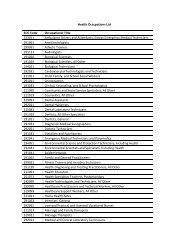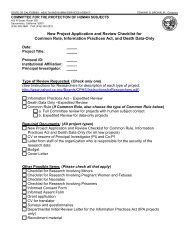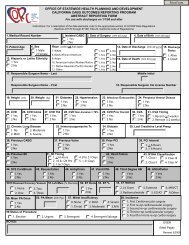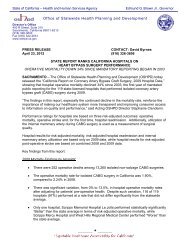Best Practices for Project Management, Design, and Construction of ...
Best Practices for Project Management, Design, and Construction of ...
Best Practices for Project Management, Design, and Construction of ...
You also want an ePaper? Increase the reach of your titles
YUMPU automatically turns print PDFs into web optimized ePapers that Google loves.
Section 4: Inspector <strong>of</strong> Record <strong>Best</strong> <strong>Practices</strong><br />
Introduction<br />
The actions <strong>of</strong> the Inspector <strong>of</strong> Record (IOR) on a project are based on the requirements outlined<br />
in Title 24, Part 1, Chapter 7 <strong>of</strong> the Cali<strong>for</strong>nia Code <strong>of</strong> Regulations (CCR).<br />
The IOR is interviewed <strong>and</strong> approved <strong>for</strong> each project by the design pr<strong>of</strong>essional <strong>of</strong> record as<br />
appropriate <strong>and</strong> works under the direction <strong>of</strong> the Architect <strong>of</strong> Record (AOR) <strong>and</strong>/or the Engineer <strong>of</strong><br />
Record (EOR) (see Title 24, Part 1, Chapter 7, Section 7-145 <strong>of</strong> the CCR); is employed by the<br />
hospital governing board or authority; <strong>and</strong> is then approved <strong>for</strong> the project <strong>and</strong> monitored<br />
by OSHPD <strong>for</strong> competence <strong>and</strong> adequately ensuring compliance (see Title 24, Section<br />
7-213 <strong>of</strong> the CCR).<br />
When questions arise the IOR should consult the owner <strong>and</strong> the AOR <strong>and</strong>/or the EOR. The<br />
appropriate OSHPD personnel associated with the project, including the Compliance Officer<br />
(CO), Fire Life Safety Officer (FLSO), District Structural Engineer (DSE), <strong>and</strong> the Regional<br />
Compliance Officer (RCO) should be consulted as needed.<br />
It takes much more than simply having an OSHPD certification to be an OSHPD inspector.<br />
Complex hospital construction requires the right kind <strong>of</strong> inspector with the right kind <strong>of</strong><br />
background <strong>for</strong> the project to be constructed. Inspectors help make a project successful by doing<br />
their job properly <strong>and</strong> effectively without ever compromising their position. This chapter gives a<br />
general description <strong>of</strong> the duties <strong>and</strong> responsibilities, with insight to the best practices <strong>for</strong> the IOR<br />
along with an overview <strong>of</strong> the necessary working relationships required <strong>for</strong> a successful project.<br />
Conduct<br />
In recognition <strong>of</strong> the responsibility <strong>of</strong> their position, the IORs should observe the following rules<br />
governing their personal conduct:<br />
• Be patient, tactful, <strong>and</strong> respectful.<br />
• Have no personal connection with any individual, either directly or indirectly, <strong>and</strong> do not<br />
accept a loan, gift, or gratuity from any individual, contractor, subcontractor, group,<br />
company, corporation, or public body that is in any way responsible <strong>for</strong> compliance with<br />
the terms <strong>and</strong> conditions <strong>of</strong> the contract.<br />
• Never suggest or recommend <strong>for</strong> construction employment any particular person or<br />
persons or subcontractors. Nor should an IOR suggest or recommend the purchase <strong>of</strong> any<br />
specific material or product except ins<strong>of</strong>ar as the specifications may require.<br />
• Do not give directions or instructions to the contractor or any subcontractor involving any<br />
change in the work other than to stop the work if it is not covered by or constructed in<br />
accordance with the approved documents. (Only OSHPD, not the IOR, can stop work.)<br />
(OSHPD <strong>Best</strong> <strong>Practices</strong>) Page 57 DRAFT FINAL, Sept. 2011



